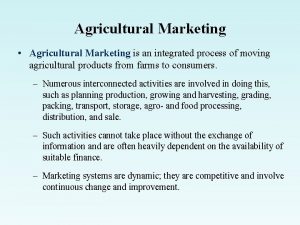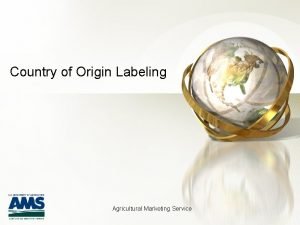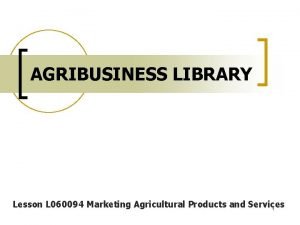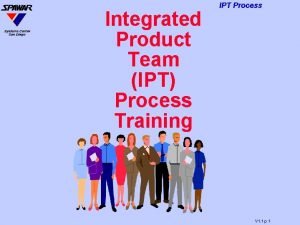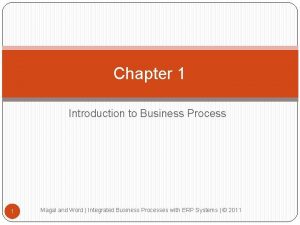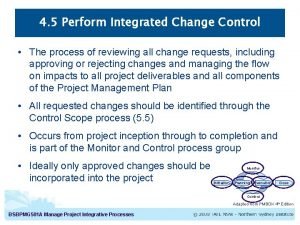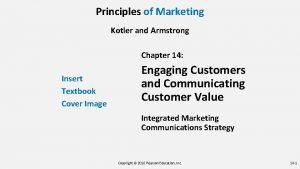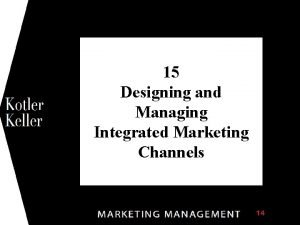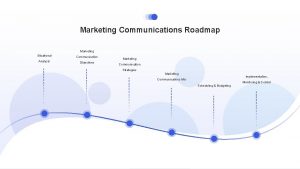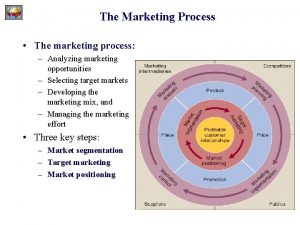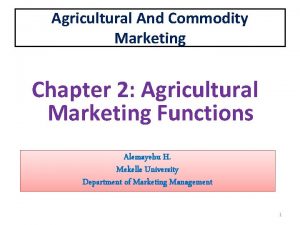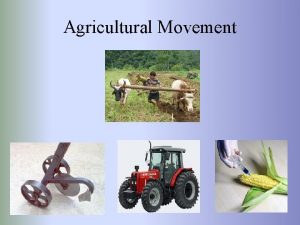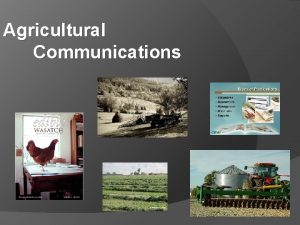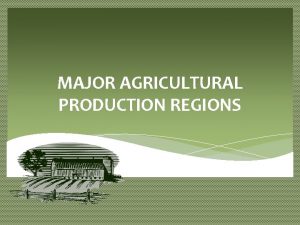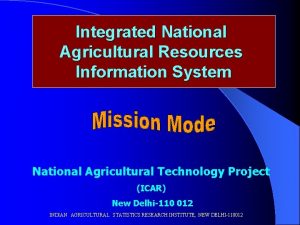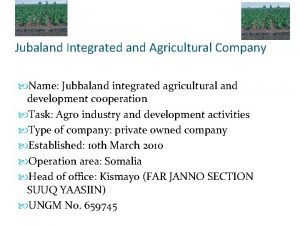Agricultural Marketing Agricultural Marketing is an integrated process



















- Slides: 19

Agricultural Marketing • Agricultural Marketing is an integrated process of moving agricultural products from farms to consumers. – Numerous interconnected activities are involved in doing this, such as planning production, growing and harvesting, grading, packing, transport, storage, agro- and food processing, distribution, and sale. – Such activities cannot take place without the exchange of information and are often heavily dependent on the availability of suitable finance. – Marketing systems are dynamic; they are competitive and involve continuous change and improvement.

Agricultural Marketing • Every person in the world is affected, on a daily basis, by the way agricultural markets provide alternative quantities and qualities of various food for consumption. • The efficiency with which all of these activities occur affects prices that consumers pay for the food they purchase as well as the prices that farmers receive for their products. • Less than 2% of the US population reside on farms and obtain income directly from producing agricultural products. • A much larger fraction of the US population depends on marketing of agricultural products as a major source of income.

Consumer Food Expenditure Marketing Bill 82% Farm Value 18% + Source: USDA, 2008 = 100%

Views of Ag. Marketing The MACRO view • Macro marketing is the performance of all business activities involved in the forward flow of goods and services from the producer to the consumer. – The WHO and WHAT of Marketing The MICRO View • Micro marketing is the performance of business activities that direct the flow of goods and services to the customer and accomplish the objective of the firm. – The HOW and WHY of Marketing


Macro view: Three approaches to the study of marketing agricultural products 1. Institutional Approach: Emphasizes the “Who” of marketing Middlemen – assemblers, wholesalers, brokers, retailers, order buyers, information providers, etc. 2. Functional Approach: Emphasizes the “What” of marketing Functions that are performed in agricultural marketing – exchange functions, physical functions and facilitating functions 3. Behavioral Approach: Emphasizes the interdependence and coordination of all participants and all the functions of the entire system – combines institutional and functional approaches

Functions in Agricultural Markets —one way to analyze n n Selling Storage Transportation Processing n n n Facilitating Standardization Financing Risk bearing Market Intelligence

Selling to n Processors n n n Intermediaries n n n For final products (e. g. , flour) For manufacturing of ingredients Wholesalers Retailers Customers n n Consumers Institutions

Storage n Seasonal n n n Timing of production vs. cost of storage Feasibility of timing market (turkeys vs. wheat) Queuing

Transportation n Cost vs. speed n n Perishability Value of freshness to customers Ability to predict demand Need for bulk reduction (see processing)

Processing n n n Treatment of product (e. g. , wheat to flour) Reduction of bulk (oranges to concentrate—not orange juice yet) Creation of labor saving food products (e. g. , frozen pizza)

Facilitating n Farmers’ agents n n Matching demand supply Other information search—e. g. , demand forecast Negotiations Logistics handling

Standardization n n Agricultural grades and labeling Food branding

Financing n Long term lending n n n Short term lending n n n Farm mortgages Equipment loans Advances against harvests Financing of store and processor inventory Futures contracts

Risk Bearing n n n Futures contracts Investments in new food products (most will fail) Evaluation of credit worthiness of farmers and other parties

Market Intelligence n n Market research Forecasting n Demand n n n For existing products Spread of new products Supply

Behavioral Systems n Input-output n n Communications n n Different parties provide goods and services moving toward final products Matching supply and demand Adaptation to outside changes—e. g. , n n Consumer tastes World supply

Micro Marketing n n n From a micro, firm manager perspective, the customer is the next stage in the marketing system. What does this mean? The firm manager will play an active role in overseeing the firm’s marketing decisions that include: n Procurements and merchandising (buying and selling) n Identify consumer preference and product choice n Product design and development, processing, and packaging n Pricing n Promotion n Storage and transportation

Consumer Sovereignty n n n The economic doctrine that the consumer is Queen or King in the marketplace that is driven by consumer demand is known as Consumer Sovereignty. This is the concept that each consumer decides independently what to buy and that the combined individual decisions directs all production and marketing activities in the economy. But consumer demand is influenced by effective Advertising and Promotions
 Agriculture marketing process
Agriculture marketing process Communications mix
Communications mix Agricultural marketing circle
Agricultural marketing circle Scope of agricultural marketing
Scope of agricultural marketing Marketing mix of agricultural products
Marketing mix of agricultural products Integrated product team roles and responsibilities
Integrated product team roles and responsibilities Construct an integrated business process
Construct an integrated business process Perform integrated change control
Perform integrated change control 14 principles of marketing
14 principles of marketing What is encoding in marketing communication?
What is encoding in marketing communication? Integrated marketing communications definition
Integrated marketing communications definition Integrated marketing campaign template
Integrated marketing campaign template Designing and managing marketing communications
Designing and managing marketing communications Integrated marketing channel system
Integrated marketing channel system Introduction to integrated marketing communication
Introduction to integrated marketing communication Marketing communication mix of coca cola
Marketing communication mix of coca cola The sender of an integrated marketing communication
The sender of an integrated marketing communication Designing and managing integrated marketing communications
Designing and managing integrated marketing communications High value deal seekers
High value deal seekers Integrated marketing roadmap
Integrated marketing roadmap
